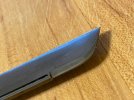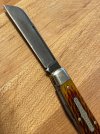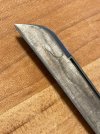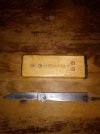- Joined
- Dec 2, 2005
- Messages
- 70,776
The BladeForums.com 2024 Traditional Knife is ready to order! See this thread for details:
https://www.bladeforums.com/threads/bladeforums-2024-traditional-knife.2003187/
Price is $300 $250 ea (shipped within CONUS). If you live outside the US, I will contact you after your order for extra shipping charges.
Order here: https://www.bladeforums.com/help/2024-traditional/ - Order as many as you like, we have plenty.







I would work on the blade and the caplifter with sand paper on a very flat surface starting at 80 or 120 grit and just going back and forth as close to the tag as you can and progress up to about 600 then you’d want to put the sand paper on a mousepad and go in one direction carefully to clean up the sandpaper marks which if done well will start to look like the factory grind the mouse pad will help the sandpaper fully stay in contact with the blade and will also get to areas that if it were on a flat hard surface might get missed. It ends up convexing the edge a little too. I would not do much with the blade well and just maybe give the whole thing a dip in vinegar for 20-30 minutes taking it out every few minutes to scratch at the rust in the blade well with a toothpick to get off any red rust then I’d wash in hot water with some soap and rinse it dry it and oil it, the vinegar and oil will basically turn the rust to patina. Here are a couple pics of one I did that had a bit of a divot towards the front edge it’s still there a little bit and I tried to show it in the pics but it is less noticeable than it was. If those deemed marks are too deep you may not want to try to fully get rid of them and just minimize the appearance.Perfect! I was going to post asking for help. I acquired this beauty recently, and would love to give her a home spa treatment. Looks like she was left to rust and then took a solid dremeling. Can someone point me towards some threads on treating the rust inside frame on springs and how to get the grinds off the flats? Walk and talk is great!View attachment 1508879View attachment 1508880View attachment 1508881View attachment 1508882View attachment 1508883View attachment 1508884View attachment 1508885View attachment 1508886View attachment 1508887View attachment 1508888





Not worn out, by any means, but worn down some. My maternal grandfather's 3-layer scout with prewar type can opener.

Not a mark on it anywhere, that I can see.



Maybe they should require some sort of license to operate a Dremel.

After just a little work, it's still an oddly shaped blade, but it cuts well.


Oh. My. God!
That degree of abuse of a knife via grinding, really should be a public flogging offense!

Maybe they should require some sort of license to operate a Dremel.

After just a little work, it's still an oddly shaped blade, but it cuts well.



I dunno, I'd rather people do that then snap half the blade off usimg it as a crow bar... at least this way there is more to salvage.

Maybe they should require some sort of license to operate a Dremel.

After just a little work, it's still an oddly shaped blade, but it cuts well.


Oh. My. God!
That degree of abuse of a knife via grinding, really should be a public flogging offense!
I dunno, I'd rather people do that then snap half the blade off usimg it as a crow bar... at least this way there is more to salvage.
